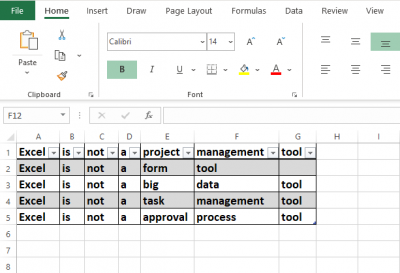Excel không phù hợp cho việc lập cơ sở dữ liệu
Lý do:: Excel không cản ta làm điều mà ta sẽ hối tiếc
Excel là sản phẩm low code tồn tại lâu dài nhất
Việc lập trình ít trực giác hơn nhưng lại có nhiều đánh đổi hơn các ngành khác
Excel as a database - Neopoleon¶
As a developer, you’ve probably, at some unfortunate point in your life (possibly several points, actually), been handed an Excel file that has been crammed full of “data” by someone in marketing and told to “do something with it.”
Columns probably didn’t line up, and a thousand different fonts were used. Every feature of Excel was probably abused and abused again in order to avoid having to use an actual database application for storage of the data.
Of course, it’s up to you to make sense of the layout, and they could just give a bleepity-bleep about what a pain in the ass it is to suck weird data out of Excel and “do something with it” when little or (more often) no thought has been given to possibly making the data consistent or, dare I say, orderly.
To this end, I’ve put together another art project. This time, what you will see unfold before your peepers is a process of discovery – My thoughts on how these files are created.
[Note: I wound up drawing one of the characters with fangs and, eventually, “crazy eyes” – I don’t know why I did this. It just felt right. ]
Hey – I know what you’re thinking: “That was a little weird”
5 Things You Should Stop Doing with Microsoft Excel¶
Before you start the article, we wanted you to know that workflow automation can help wean people off of using Excel for the wrong reasons. Check out what’s possible.
Excel is a great tool but it’s often used in ways it was never intended. We suggest some of the ways it should never be used.¶
Microsoft Excel is a powerful spreadsheet that has been greatly refined over the past 30 years, especially with the development of macros. However, these capabilities have prompted many people to use Excel in ways for which it was never designed. For example, Excel isn’t a database, although many people use it as one. Excel may be able to serve this function for smaller data sets with simple rules, but a data set can quickly exceed Excel’s limitations as it grows.
There are far better tools out there to handle the specific use cases for which Excel is ill-equipped. Here are some of those use cases.
Forms¶
There are several reasons to avoid using Excel for forms. For instance:
- Data entered into forms is typically disconnected from any database. Most Excel forms are just spreadsheets with blank cells to type into. This is only marginally better than a paper form.
- Format and layout are cumbersome and time-consuming. To design a user-friendly form in Excel is a brutal exercise.
- There are limited methods to control and validate input, resulting in bad data capture. Any attempts at validation are easily avoided.
Excel was not designed for creating forms and to get a usable form that collects and stores data is prone to issues and simply not worth the effort. You’re better off using a tool built for designing forms and handling data in a sensible way.
Project Management¶
Excel is often used for project planning, usually for small to midsize projects. The primary reason many people use Excel is that many team members are unfamiliar with project planning software options (or don’t have budget for them) and Excel is readily available. Also, there are Excel project planning templates available for download. For simple solo projects that are basically a list of tasks and dates, Excel can be fairly effective.
However, multiple users can’t work on the same Excel template at the same time unless your team is using the online version. Even then, it’s easy to trip over each other while trying to edit. It also doesn’t handle complex projects well and can become a densely-packed, color-coded nightmare for everyone except the person who created it.
Furthermore, updating statuses manually and generating the required reports in Excel can more time than the work itself. Dedicated project management software allows users to visualize and update the entire process of planning, reporting and monitoring a project in real-time. Manual data entry and duplicate reports are no longer a concern since all team members receive updates with the same report.











